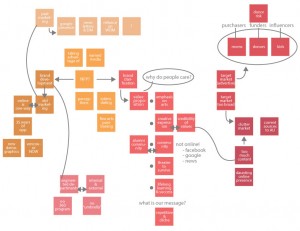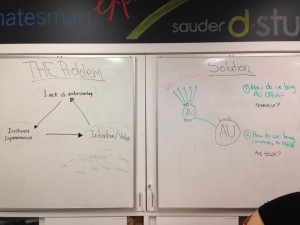Being able to learn in a space like the d-studio was the highlight of my semester this year. After being forced to think in a repetitively linear way for the week, it was a relief to be able to be in a setting where I didn’t have to restrict my thinking.
In my first reflective diary, I explored how I relied more on my right brained, and how I rely on visual brainstorming to map out my ideas. Over the
 course of the semester, I’ve learned how to refine and structure my thinking using the Ask-Try-Do process.
course of the semester, I’ve learned how to refine and structure my thinking using the Ask-Try-Do process.
In the future, I will continue to apply design thinking frameworks to approach solving problems. Through the design brief and deep dive assignments, I’ve learned how to be comfortable with chaos, which has resulted in being able to be more open-minded. I’ve realized that in the brainstorming stage, I don’t need to go right into making lists or identifying patterns. It’s much more useful to apply design thinking strategies in a preliminary step to explore different aspects of an idea.
We learned many design thinking strategies this semester, but the ones I found most useful were the Assumption Dumption, Concept Mapping, and Bad Ideas. The first two techniques were used extensively by my team (Marketing) during the design brief. When we first started brainstorming, we instinctively fell to our old thinking habits—skipping divergent thinking and going straight to trying to come up with logical ideas. I remember clearly the team sitting in Birmingham for more than 3 hours, working with no inspiration and coming up with nothing useful. We then made the executive decision to move to the d-studio to work. Once we were there, it was like magic. Using the white boards, we applied Assumption Dumption and Concept Mapping and in just one hour, we finished the assignment.
but the ones I found most useful were the Assumption Dumption, Concept Mapping, and Bad Ideas. The first two techniques were used extensively by my team (Marketing) during the design brief. When we first started brainstorming, we instinctively fell to our old thinking habits—skipping divergent thinking and going straight to trying to come up with logical ideas. I remember clearly the team sitting in Birmingham for more than 3 hours, working with no inspiration and coming up with nothing useful. We then made the executive decision to move to the d-studio to work. Once we were there, it was like magic. Using the white boards, we applied Assumption Dumption and Concept Mapping and in just one hour, we finished the assignment.
I will also approach problem solving differently in the sense that I will approaching teamwork differently. In other classes, projects that require groupwork are often done individually—“teamwork” simply means splitting up parts and writing your part on your own. Working in the d-studio really taught me the merit of teamwork and the value of many minds working towards a goal. Not only do we work extensively within our own teams, applying design thinking strategies, but the class works together as a whole. I have never been in an environment where “beg-borrow-share” is so actively practiced. Judging from everyone’s final presentations, this technique can be very successful.
I think Team Academy completely embodied the essence of design thinking in their studio presentation. The “Pathways” solution they reached after the deep dive process was extremely innovative and well-designed. It was fascinating to see their final result after watching their “develop” process on the double diamond framework.
Having the opportunity to spend this semester in the d-studio will forever have a fundamental impact on my thinking habits. I am now much more aware of my critical voice, and understand that although it may result in chaos, it can be helpful to silence it. Design thinking is about bridging divergent thinking and convergent thinking—I am excited to apply this to all future problems to come up with innovation and well-designed solutions.
